I have just read
The Penelopiad. In it Margaret Atwood amusingly retells the story of Odysseus's faithful wife in her own words. The time is now. The location is Hades, the fields of asphodel. After millenia as a shade, Penelope is still jealous of gorgeous, selfish, vain Helen. She's still angry for a lifetime of mistreatment and increasingly irritated at mythological misinformation about herself. We hear all about the dishonest nature of wily Odysseus, how she often saw through his tricks, and how much less savory he was in "reality" than in Homer's version. As a shade, she knows all about Homer's version and all the subsequent versions.
Penelope doesn't like her life in Hades much; however, she resists rebirth. In contrast, since his death Odysseus has been "a French general, he's been a Mongolian invader, he's been a tycoon in America, he's been a headhunter in Borneo. He's been a film star, an inventor, an advertising man." (p. 189-90)
My favorite quote from poor Penelope: "More recently, some of us have been able to infiltrate the new ethereal-wave system that now encircles the globe, and to travel around that way, looking out at the world through the flat, illuminated surfaces that serve as domestic shrines. Perhaps that's how the gods were able to come and go as quickly as they did back then -- they must have had something like that at their disposal." (p. 19)
It's a good fun read -- far less challenging than many books by Atwood.
As I read I began to think how many authors have loved to retell old stories in new ways and forms: classic stories from mythology, Arthurian legend, Shakespeare, etc. Some retellings are straightforward; others, like
West Side Story, reuse the essential plot in modern dress. The best, like Atwood's tale, refocus from the point of view of a minor or underdeveloped character. The goal may be irony, politics, or curiosity.
My mind exploded with examples:
- Virgil wrote the Aeneid to create a Roman founder myth based in the Trojan war.
- A Connecticut Yankee in King Arthur's Court provided Mark Twain with ironic distance from the follies of his own era.
- Jean Rhys wrote Wide Sargasso Sea to recreate the first Mrs. Rochester. (She's not the only one to write a story based on this unloved madwoman.)
- Anita Diamant's best seller The Red Tent tried a historic-anthropological take on women in early biblical times through the character of Dinah.
- Wicked, first a novel, later a hit musical, devised a new adults-only personality for the Wicked Witch of Oz. (Author Gregory Maguire has subsequently redone several other children's stories in the same vein.)
- An older Broadway success is The Skin of Our Teeth -- Thornton Wilder mines the Bible. Cute and universal. Now material for high school drama clubs.
- In a heavier spirit, Par Lagerkvist created an identity for the crucified thief of Golgotha in Barabbas. (I think this blip has left the radar screen.)
- Aldous Huxley offered a distopian version of The Tempest in Brave New World.
- And I can't forget Hollywood's homage to Emma, the movie Clueless.
After winning a lawsuit about copyright, Alice Randall's The Wind Done Gone -- same story, slave's point of view, Gone With the Wind -- dropped out of sight like a stone. I've never read either book. But I've read/seen all the others on this list. And I know there are lots more, such as at least two more recent retells borrowing characters from Jane Austen novels.
The lawsuit proved that this kind of book isn't a crime. Is it a genre? I don't know.




 Then food and conversations. I was terrible: everyone brought wonderful home-made things like chicken salad, noodle dishes, deviled eggs, artichoke dip, spicy shrimp, cookies, scones... But I went to Trader Joe's and got grapes, a cheese log, and crackers. I feel bad. Next year I promise to bake!
Then food and conversations. I was terrible: everyone brought wonderful home-made things like chicken salad, noodle dishes, deviled eggs, artichoke dip, spicy shrimp, cookies, scones... But I went to Trader Joe's and got grapes, a cheese log, and crackers. I feel bad. Next year I promise to bake!


 I have a lot more photos -- but I tried to be selective.
I have a lot more photos -- but I tried to be selective.


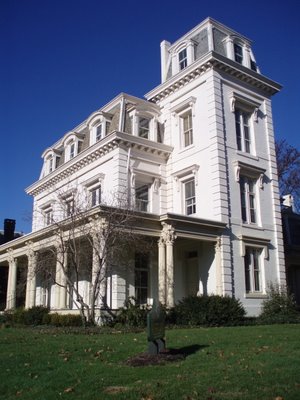
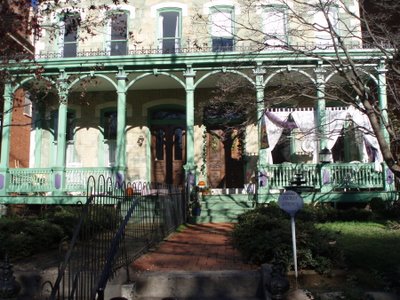




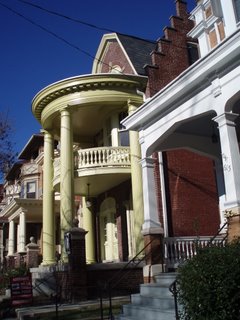

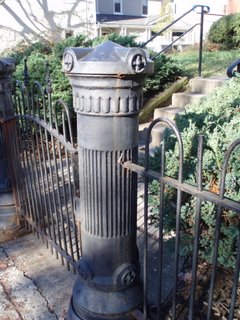


 Language Myths edited by Laurie Bauer and Peter Trudgill. This book is a collection of essays by experts on things that many people wrongly or pretty wrongly believe to be true of language. Some of the essays pointed out things I knew; others were quite new to me.
Language Myths edited by Laurie Bauer and Peter Trudgill. This book is a collection of essays by experts on things that many people wrongly or pretty wrongly believe to be true of language. Some of the essays pointed out things I knew; others were quite new to me.

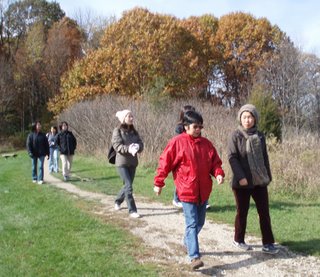 I talked to several of the other hikers, and I learned something really interesting from Katie. We were talking about making blogs, and she explained how one enters Japanese characters into a computer -- or a blog. She says one types the phonetic word into the computer (in the Hiragana alphabet). The computer returns the equivalent character (or a choice of possible equivalent character) in the pictorial system. The typist selects the desired character, thus creating a correct version of his or her text. I find this really fascinating.
I talked to several of the other hikers, and I learned something really interesting from Katie. We were talking about making blogs, and she explained how one enters Japanese characters into a computer -- or a blog. She says one types the phonetic word into the computer (in the Hiragana alphabet). The computer returns the equivalent character (or a choice of possible equivalent character) in the pictorial system. The typist selects the desired character, thus creating a correct version of his or her text. I find this really fascinating.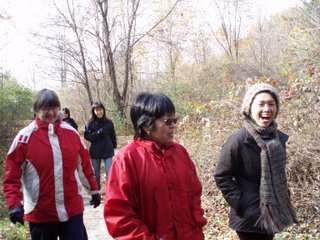






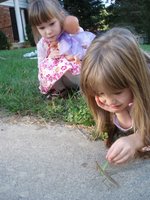

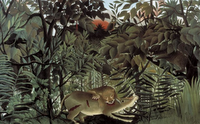
 Today was my first hike with the International Neighbors Hiking Group. We started at the church on Webster Church Road, walked to Zeeb Road, up to a llama farm, and back to the church. On the way, we saw huge puff balls, and passed by a farm whose inhabitants love to draw murals on the sides of their buildings.
Today was my first hike with the International Neighbors Hiking Group. We started at the church on Webster Church Road, walked to Zeeb Road, up to a llama farm, and back to the church. On the way, we saw huge puff balls, and passed by a farm whose inhabitants love to draw murals on the sides of their buildings.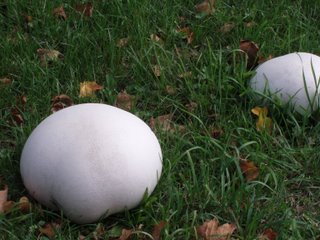

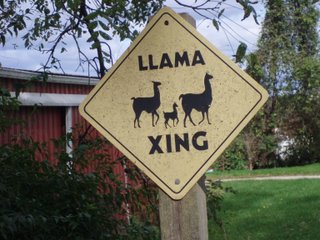 After the walk, the church's gardner -- a friend of the hike leader -- invited us to eat our sack lunches in the garden. From the picnic tables we enjoyed the view of her colorful flowers and vegetables. Her sweet potato plants spread down from their raised bed: the church has a relationship with people from Ghana, who love to cook and eat sweet potato leaves as well as the tubers. Unfortunately the weather has turned very cool, so it was not entirely comfortable to eat outdoors.
After the walk, the church's gardner -- a friend of the hike leader -- invited us to eat our sack lunches in the garden. From the picnic tables we enjoyed the view of her colorful flowers and vegetables. Her sweet potato plants spread down from their raised bed: the church has a relationship with people from Ghana, who love to cook and eat sweet potato leaves as well as the tubers. Unfortunately the weather has turned very cool, so it was not entirely comfortable to eat outdoors.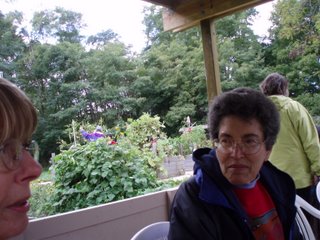

 The old stove (which wasn't working right) with old countertops etc:
The old stove (which wasn't working right) with old countertops etc: The new sink with space age faucet -- the tile color is actually blue with glass tile accents:
The new sink with space age faucet -- the tile color is actually blue with glass tile accents:
 The new faucets and new tile backsplash in the downstairs bathroom:
The new faucets and new tile backsplash in the downstairs bathroom: The old bathroom setup:
The old bathroom setup: